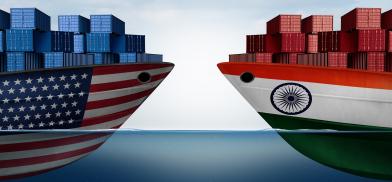India’s Strong Economic Fundamentals Shield It from Trump’s Tariff Threat — and Challenge Vietnam
Trump’s renewed tariff war may upend the global trade landscape once again, but India is well-positioned to weather the storm. Its strong domestic economic fundamentals, relatively low dependence on merchandise exports for GDP growth, and diversified export base put it at a strategic advantage—particularly over export-heavy rivals like Vietnam and China.

Despite the turbulence caused by the COVID-19 pandemic and ensuing geo-economic shifts, India has continued to post robust growth. The country recorded a 9.2 percent GDP increase in 2023–24 and is projected to grow at 6.5 percent in 2024–25—building on an already strong performance in the previous year. This has surprised many, especially against the backdrop of global economic deceleration, with the IMF projecting global growth at just 3.3 percent in 2023 and 3.2 percent in 2024.
India’s consumer price index (CPI) inflation eased from 5.6 percent in 2023–24 to 4.6 percent in 2024–25. Despite global trade headwinds, exports registered a marginal uptick of 0.14 percent in 2024–25. The industrial sector posted an impressive 10.9 percent growth in 2023–24 and sustained momentum with 5.9 percent growth in 2024–25.
This resilience underscores the strength of India’s macroeconomic fundamentals—enabling it to weather external challenges such as the latest round of tariffs announced by former U.S. President Donald Trump.
Exports Not the Core Driver of Growth
India's growth story is largely domestically driven. Unlike many export-oriented economies, India’s economic momentum relies more on internal demand and investment than on merchandise exports.
According to the IMF, merchandise goods and services exports accounted for 21.8 percent of India’s GDP in 2021–22. Of this, merchandise goods—the segment vulnerable to Trump's tariffs—contributed just 13 percent. This is significantly lower than export-dependent economies such as Thailand (70.1 percent), Malaysia (71.4 percent), and the European Union (40.3 percent), as per World Bank data.
As per India’s Press Information Bureau (PIB), total exports (goods and services) in 2023–24 were valued at US$ 778.2 billion. Merchandise exports made up US$ 437.0 billion, while services accounted for US$ 341.1 billion, meaning goods comprised 56.2 percent of total exports.
The U.S. as India’s Top Export Destination
The United States remains India’s largest export market, accounting for one-fifth of its total exports. In 2024–25, India exported goods worth US$ 86.6 billion to the U.S., making up 19.8 percent of total exports. In contrast, imports from the U.S. stood at US$ 45.3 billion, giving India a favorable trade balance of US$ 41.3 billion.
However, given that merchandise exports to the U.S. make up just around 2.5 percent of India’s GDP, any new tariff measures are unlikely to significantly derail India’s broader economic growth trajectory.
India’s Export Composition: A Strategic Advantage
India’s exports to the U.S. are concentrated in four key sectors: electronic components, textiles (including garments), gems and jewelry (notably diamonds), and pharmaceuticals. These four sectors accounted for 58.5 percent of India’s exports to the U.S. in 2024–25.
Of these, textiles and gems are labor-intensive industries—areas where India holds a comparative advantage over competitors like Vietnam and China. While electronics and pharmaceuticals face stiff global competition, India’s diversified export portfolio and its large domestic market offer a buffer against external shocks.
Vietnam in the Crosshairs
On July 2, 2025, Trump announced tariffs of 20 percent on several Vietnamese goods and a steep 40 percent on items suspected to be transshipped from third countries—primarily China. Transshipping, often used to mask the true country of origin to evade tariffs, has become a contentious issue.
Analysts estimate that approximately 16 percent of Vietnam’s exports to the U.S. involve transshipped goods, much of it originating from China. Key sectors include textiles and electronics—areas where Vietnam currently outpaces India in volume. In 2023, Vietnam exported US$ 11 billion worth of textiles and garments, and US$ 35.9 billion worth of electronics to the U.S.—60 percent and 300 percent more than India, respectively.
Yet, India may gain the upper hand. While Vietnam currently enjoys a lower baseline tariff (20 percent vs. India’s 26 percent), the new 40 percent penalty on transshipped goods could undercut its competitive edge, especially given China’s role in Vietnam’s export ecosystem.
The Pharma Angle: India vs. China
Trump’s April 2025 announcement also slapped a 34 percent tariff on Chinese goods—higher than the 26 percent imposed on Indian exports. This is particularly significant in the pharmaceutical sector. China leads in exporting active pharmaceutical ingredients (APIs) and finished drugs, while India is dominant in generic drugs—especially to the U.S.
This distinction may work in India’s favor, as the U.S. increasingly diversifies away from Chinese suppliers, especially in strategic sectors such as healthcare.
Needed Policy Recalibrations
Trump’s renewed tariff war may upend the global trade landscape once again, but India is well-positioned to weather the storm. Its strong domestic economic fundamentals, relatively low dependence on merchandise exports for GDP growth, and diversified export base put it at a strategic advantage—particularly over export-heavy rivals like Vietnam and China.
With prudent policy recalibrations and proactive diplomatic engagement with the U.S., India can not only mitigate the impact of new tariffs but also capitalize on shifting trade dynamics to strengthen its global export footprint.
(The writer is an Indian trade consultant and analyst. Views expressed are personal. He can be contacted at subratamajumder0604@gmail.com)









Post a Comment